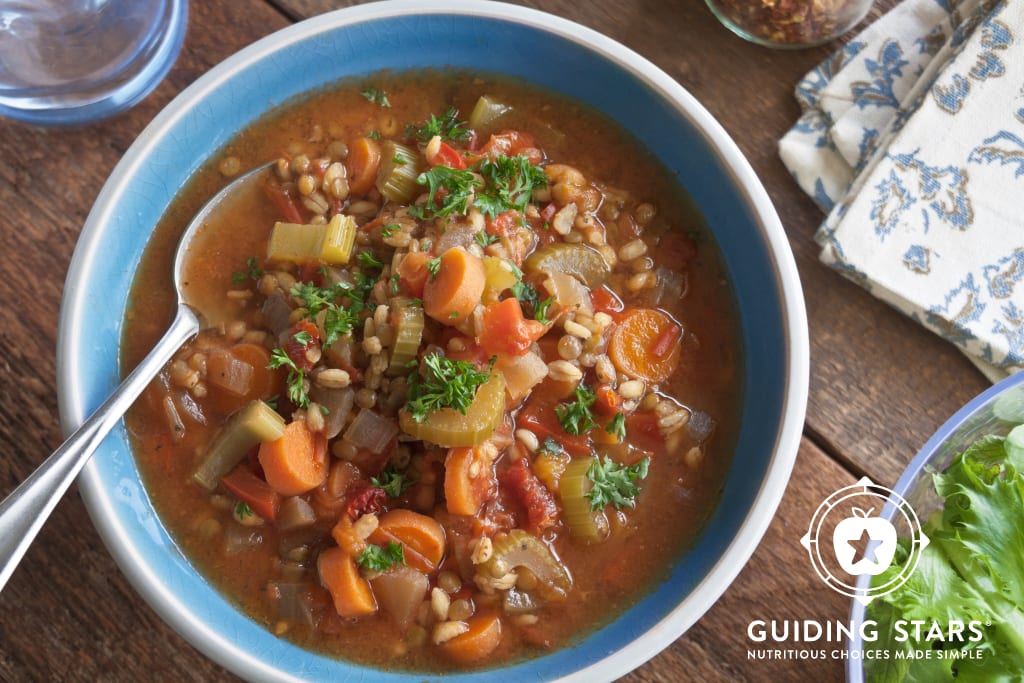
Is your commitment to eating seasonally starting to peter out right about now? If so, you’re not alone. In the winter, produce selection is distinctly smaller than at other times of year, so it can be hard to feel motivated to load up on local fruits and veggies. Nevertheless, I’m a firm believer that everyone can find at least a couple of seasonal favorites.
Eating seasonally in the winter typically means choosing the fruits and veggies that are available, either locally or regionally. I live in New England, where regional produce in the winter isn’t packed with variety. But options still exist—in produce departments, as part of a winter CSA share, or at a winter farmer’s market. We’ve discussed the benefits of eating seasonally and locally in this blog before. My focus here is to help convince you to incorporate more seasonal produce into your diet. What’s my top suggestion? Rely on your soup pot this season, and here’s why:
Soup is familiar
A bowl of soup, warm and nourishing, is a regular culinary comfort for many of us in the winter months. In fact, I make soup at least once a week from December through March. Soup is like an old friend that we welcome to the table—not fussy, and easy and enjoyable to have around. This familiarity we have with soup makes it a good dish to try with unfamiliar ingredients—somehow it just feels “safer.” Consider adding hardy winter vegetables you don’t often eat to a big pot of soup you know you already like. For example, try cauliflower or leafy greens in a simple minestrone or your favorite vegetable soup. (Check out this Guiding Stars recipe for an easy winter vegetable soup.)
Soup is endlessly versatile
If there is a more versatile dish than soup, I haven’t heard of it! A tasty soup can be made out of broth (or water!), leftovers in your fridge, and pantry staples. (Check out this great blog series on cooking with leftovers and “nextovers.”) There are so many options, and you don’t have to be a chef to toss together a slurp-worthy soup. Soup is very forgiving—you can do some pretty adventurous things and still make an edible, if not delicious, meal. Leftover meat and poultry are easy stir-ins, as are fresh vegetables that have passed their prime. I’ve even used leftover spaghetti sauce, take-out fried rice and other cooked grain side dishes, mashed potatoes, and refrigerated condiments. The same goes for seasonal produce, really—mix it up and break out of your usual veggie rut. My favorite soup veggies are leftover ones, naturally. And don’t discount root vegetables, or white vegetables, or squashes. They all have nutritional benefits and can bring unique tastes and textures to a bowl of soup.
Soup can save you money
Soup can certainly be made with expensive ingredients, but a good seasonal soup can also be very economical. Let’s examine why. Foods in season are typically less expensive than those that are not in season. (This is primarily because out-of-season foods are transported from far away and/or have a short season/small supply.) Soup can also be created from little bits you have on hand, and leftovers (my favorite). Other ingredients for an inexpensive soup include pantry staples—dried or canned beans, lentils, canned tomatoes, rice, barley, and pasta. Even broth can be homemade and, of course, lots of soups call for water as the main liquid. So not only can a pot of soup cost very little per serving, soup recipes often yield many servings. (For the life of me, I can’t figure out why every soup I create—no recipe—makes at least eight servings! Not complaining though.) This means you can eat for days from one soup recipe. Or freeze some for another day when you want soup but don’t have the time or inclination to make it. Soup is an all-around bargain (for other money-saving cooking and shopping tips, read this post, and this one). Looking for recipes? This lentil and barley soup is a nutritious and inexpensive meal, as is this cabbage soup.
Soup is easy
I’m sure you could dig up a complicated, 15-step soup recipe if you wanted to. But for the most part, putting together a soup is easy. That’s one of the things I like most about it. In fact, teaching my children how to make soup was one of the first cooking lessons I gave them. I figure if you can put together a soup, you will always be able to feed yourself. In many cases, putting together a soup is just a matter of combining and heating the ingredients. Sometimes you don’t even have to follow the steps exactly in the order specified and it still turns out (yay!). However, I always recommend reading through the entire recipe before starting to cook—that goes for all recipes, not just soup. Finally, for the ultimate in easy, consider using a slow cooker for soup, stew, or chili. You can be off living your life while your soup is cooking—it doesn’t get much easier than that.